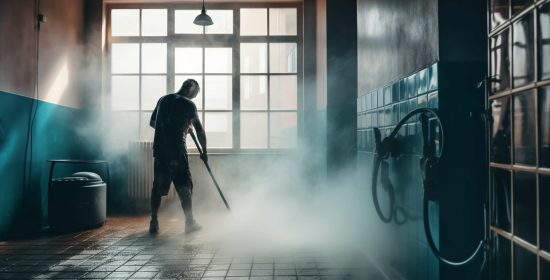
Mould is a silent intruder that can wreak havoc in your home. It doesn’t need an invitation to appear; it simply thrives in damp, dark corners. If not taken care of properly, mould issues in your home will spell even more trouble for you in the long run.
In this article, we’ll explore the threats of mould, identify common mould-prone areas, and discuss the role of deep cleaning and sanitisation in safeguarding your home. We’ll also highlight the importance of hiring professional cleaning services like WonderKlean that have the know-how to secure your home from the dangers of mould.
How Mould Starts
Mould can take root in your home in various ways. It often starts with moisture buildup, whether from a leak, inadequate ventilation, or high humidity.
Once it finds a damp spot to settle, it begins to spread into colonies which increase the risk of spreading to other areas in your home. Mould can take hold in as little as 24 to 48 hours, making early detection essential.
The Threats of Mould

The consequences of mould exposure are not to be underestimated. Mould particles and colonies of these microbes can lead to various issues, including:
Infections
Some mould species can produce mycotoxins, which, if inhaled, ingested, or touched, can lead to infections and health complications.
Allergies
Mould spores can trigger allergic reactions, causing symptoms like sneezing, runny nose, itchy eyes, and skin irritation in susceptible individuals.
Respiratory Issues
Prolonged exposure to mould can exacerbate respiratory conditions such as asthma and bronchitis, leading to more frequent and severe symptoms.
Infections
Some mould species can produce mycotoxins, which, if inhaled, ingested, or touched, can lead to infections and health complications.
Allergies
Mould spores can trigger allergic reactions, causing symptoms like sneezing, runny nose, itchy eyes, and skin irritation in susceptible individuals.
Respiratory Issues
Prolonged exposure to mould can exacerbate respiratory conditions such as asthma and bronchitis, leading to more frequent and severe symptoms.
Damage to Items
Mould can damage and deteriorate personal belongings like clothing, books, and furniture if left unchecked especially in damp areas.
Structural Damage
Untreated mould can weaken walls, ceilings, and floors, causing structural problems in your home. This increases the risk of your home deteriorating quickly and can be dangerous in extreme cases.
Rapid Growth
Mould can establish itself in as little as 24 to 48 hours, fully maturing and spreading its spores elsewhere to cause more damage.
Damage to Personal Belongings
Mould can damage and deteriorate personal belongings like clothing, books, and furniture if left unchecked especially in damp areas.
Structural Damage
Untreated mould can weaken walls, ceilings, and floors, causing structural problems in your home. This increases the risk of your home deteriorating quickly and can be dangerous in extreme cases.
Rapid Growth
Mould can establish itself in as little as 24 to 48 hours, fully maturing and spreading its spores elsewhere to cause more damage.
Identifying Mould Prone Areas

Bathrooms
Bathrooms are the number one place where you will find mould in your house due to frequent moisture exposure. Shower stalls, tiles, and the space around the sink are common areas where mould can thrive and spread.

Kitchens

Basements

Closets
Storing your clothes in closets, especially those against exterior walls, includes the risk of them being affected by mould, particularly if they lack proper airflow. Check for any musty odours or discoloured patches on clothing and walls.

Air Ducts
The dust and humidity in air ducts can create a breeding ground for mould. Regular inspection and cleaning of ducts are essential to prevent mould from spreading throughout your home.

Attics
While not as common in Malaysia, attics have a high chance of trapping moisture, especially if they have poor airflow. Watch for signs of mould on the underside of the roof or in insulation materials.

Window Sills
Condensation can accumulate on window sills, providing a source of moisture for mould. Keep an eye on these areas, particularly in rainy and monsoon seasons.

Ceiling Corners
High humidity and poor air circulation in some rooms can lead to mould growth in ceiling corners. Regularly check for any dark spots or discolouration in all rooms.

Garages
Garages can be prone to moisture intrusion, especially if they are not well-sealed. Check for mould in corners and on stored items.
The Role of Deep Cleaning and Sanitisation

To effectively combat mould, the role of deep cleaning cannot be overstated. The process starts with identifying mould-prone areas and thoroughly cleaning and disinfecting them. To tackle mould issues at their source, you need to ensure that you have the right equipment and the know-how to keep mould from growing back again.
While it’s true that homeowners can attempt mould removal on their own, there are distinct advantages to entrusting this task to professionals.
Professional Assistance to Prevent Mould Issues at Home
Hiring a professional cleaning service like WonderKlean is an investment in your home’s health and safety. WonderKlean offers home disinfection and sanitisation services which covers all areas of your property.

Some of the services we offer include:

Some of the services we offer include:
Hire Reliable Home Cleaning Services Today
By relying on a home sanitising servicing like WonderKlean, you ensure a safe and mould-free environment for your family. With their deep cleaning and sanitisation services, you can enjoy a healthier, mould-free living environment.
Get in touch with WonderKlean today to experience an all-inclusive home cleaning service that will keep mould from invading your home.



